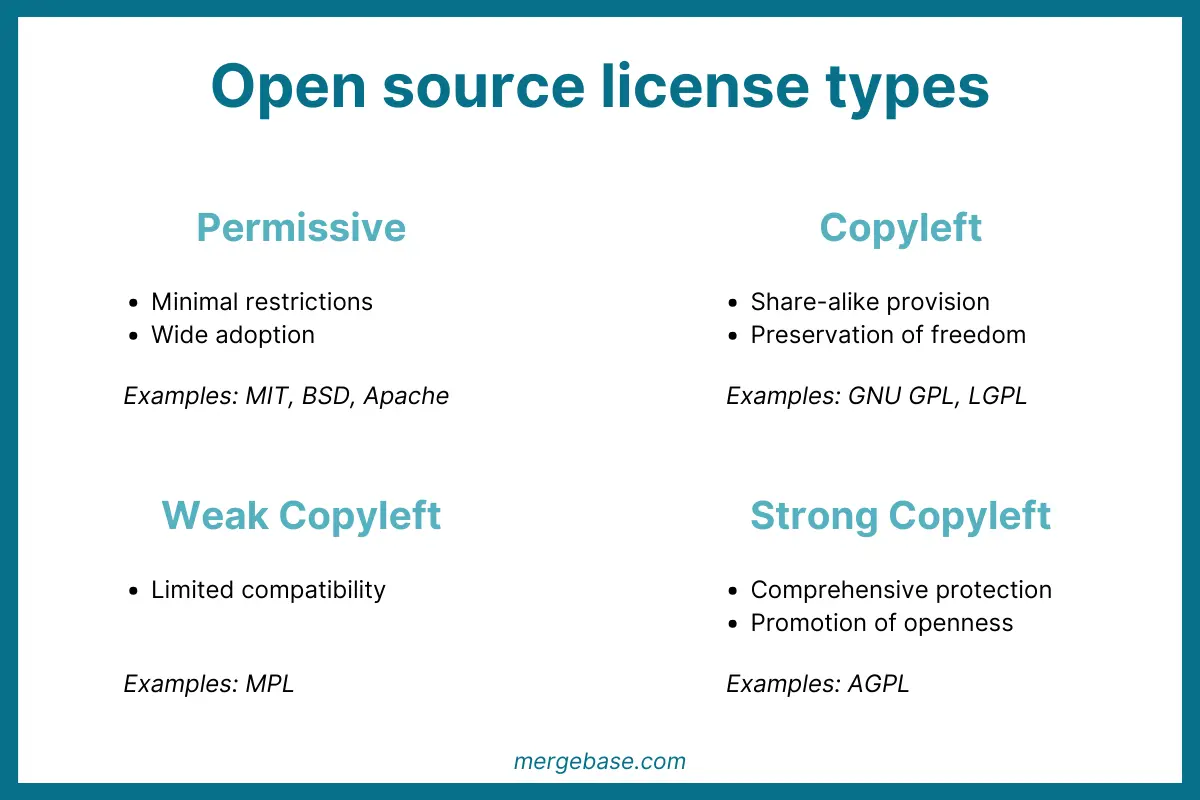Introduction to Open Source Licenses
What is an open source license?
Open source licenses are software licenses that grant users permission to use, modify, and distribute software under certain terms and conditions. These licenses ensure the software’s source code is available to the public, allowing anyone to inspect, modify, and improve it.
4 benefits of open source licenses for the software development industry
Open source licenses enable
-
Collaboration and innovation: Open source licenses promote developer collaborations by allowing them to easily (and freely) access and contribute to software projects, resulting in higher levels of innovation.
-
Transparency and accountability: The accessible nature of open source code holds developers accountable for the quality of their code and enables users to understand how the software works and more easily identify security vulnerabilities or bugs.
-
Flexibility and customization: Open source licenses allow developers to customize and adapt existing software to their specific requirements without building from scratch.
-
Cost-effective development: Most open source software is available for free, reducing the financial barriers to accessing and utilizing technology. This enables individuals or businesses with limited resources to develop high-quality products without overstretching their budgets.
Open Source License Types

Permissive licenses
One of the most flexible open source license types, permissive licenses offer users extensive freedom to use, modify, and distribute the licensed software with minimal restrictions. Typically, permissive licenses only require attribution and a disclaimer of warranty.
Key characteristics of permissive licenses include:
- Minimal restrictions: Permissive licenses impose few restrictions on how the software can be used or redistributed. This freedom allows developers to incorporate the code into proprietary projects without having to release their modifications under the same license.
- Wide adoption: Due to their simplicity and flexibility, permissive licenses are some of the most widely used open source license types and are popular with developers and organizations of all sizes.
Examples of permissive licenses include: MIT License, BSD License, and Apache License.
Copyleft licenses
Copyleft licenses require derivative works to be distributed under the same terms as the original work. Unlike permissive licenses, copyleft licenses have restrictions on the use of the software to ensure that modifications and enhancements remain freely available.
Key characteristics of copyleft licenses include:
- Share-alike provision: Copyleft licenses stipulate that any modifications or extensions must be distributed under the same copyleft license terms, thereby preserving the open nature of the software’s code.
- Preservation of freedom: This open source license type aims to protect the freedom of the software and its users by preventing proprietary appropriation of open source code.
Examples of copyleft licenses: GNU GPL (General Public License) and LGPL (Lesser General Public License).
Weak copyleft licenses
Also known as “copyfree” licenses, weak copyleft licenses are a subset of copyleft licenses that impose fewer restrictions on derivative works than their “strong” counterparts, detailed below.
Although weak copyleft licenses require modifications to be distributed under the same license terms, they allow linking or combining the code with proprietary software without requiring it to be released under the same license.
Key characteristics of weak copyleft licenses include:
- Liberal compatibility: Weak copyleft licenses facilitate compatibility with proprietary software, making them suitable for projects that encourage collaboration between open source and proprietary development efforts.
Examples of weak copyleft licenses: Mozilla Public License (MPL).
Strong copyleft licenses
As the name suggests, strong copyleft licenses impose more stringent requirements on derivative works compared to weak copyleft licenses. Any modifications or extensions to the original open source software must be distributed under the same copyleft license terms, even when the software is combined with proprietary code.
Key characteristics of strong copyleft licenses include:
- Comprehensive protection: Strong copyleft licenses are designed to prevent the exploitation of open source code in networked environments, where software is accessed remotely over a network.
- Promotion of openness: Strong copyleft licenses prioritize the preservation of the open nature of the software and aim to prevent the creation of closed, proprietary derivatives.
Examples of strong copyleft licenses include: Affero General Public License (AGPL).
Why it’s important to choose the right software license
Choosing the right open source license is essential as it can have profound implications for the project’s trajectory and long-term viability. This is because open source licenses impact everything from legal protection and compliance to community engagement, innovation, and ecosystem dynamics.
To understand the importance of choosing the right software license, let’s look at open source software’s impact on each of these in more detail.
Legal protection: Your choice of open source license type determines the legal framework under which the software is distributed and used. As a result, choosing the appropriate license is essential for protecting the project (and its contributors) from legal disputes, as it clarifies the rights and obligations of both developers and users.
Community engagement: Your software license will also shape the project’s community and invite (or discourage) collaboration among contributors and users. Therefore, it’s important to choose a license that aligns with the values and goals of the community so you can attract a diverse range of participants and encourage active engagement in the development and maintenance efforts.
Innovation and adaptability: As we covered above, each open source license type offers varying degrees of freedom and flexibility around modifying and distributing the software. Pick too restrictive a license for your project, and you risk stifling developer innovation and reducing the opportunity for experimentation.
Ecosystem dynamics: Choosing the correct software license is essential because it influences the broader ecosystem surrounding your projection, including its adoption, sustainability, and interoperability with other projects.
Business considerations: For commercial projects, the choice of software license can have significant implications for several factors, including monetization strategies, revenue streams, and market positioning. Therefore, choosing the right open source license type is essential for ensuring long-term financial sustainability.
Compliance and governance: Each open source license type comes with specific obligations and requirements that must be adhered to. Therefore, developers must consider legal and compliance issues before choosing a software license. Establishing effective governance mechanisms is also advisable to ensure license terms are being adhered to.
Factors to Consider When Choosing an Open Source License
1. Project goals and objectives
One of the first things to consider when choosing an open source license is the project’s goals and objectives. Areas to pay particular attention to include the project’s commercialization intent and community growth goals.
For example, a permissive license may be more suitable for projects aiming to generate revenue through proprietary licensing or partnerships, as it makes it easier to attract potential collaborators or investors.
On the other hand, a copyleft license may be better suited if the primary goal is to foster an engaged community of contributors and users because it will ensure that modifications remain open and accessible.
2. Compatibility with other software licenses
Another critical factor to consider is the license’s compatibility with other software licenses being used now or in the future. That’s because compatibility with other licenses is essential for collaboration and makes distribution easier.
Always ensure that your chosen open source license is compatible with the other libraries, frameworks, or dependencies used within the project to avoid conflicts or legal issues. If appropriate, consider offering the software under multiple licenses to accommodate different use cases or business models without compromising compatibility.
3. Level of freedom required and license restrictions
As we’ve established, each license type has different requirements or restrictions around modifications and redistribution. Therefore, when choosing an open source license, it’s essential to consider the needs of your project and assess each license’s type ability to meet them.
Don’t forget to assess how each license type may influence a contributor’s ability to innovate and experiment with the software by considering factors such as code sharing, forking, and commercialization.
4. Impact on community and ecosystems
Lastly, assess how the license type may attract or deter potential contributors and users based on their preferences for openness, collaboration, and freedom. Consider also how the software license may affect the growth and longevity of the project’s ecosystem, including factors such as community dynamics, governance models, and funding opportunities.
And, as always, ensure that the software license aligns with the legal requirements and obligations of your industry and/or jurisdictions to mitigate risks and ensure the project’s legal standing and viability.
Conclusion
Selecting the appropriate open source license is essential because it impacts the project’s legal protection, community engagement, innovation, ecosystem dynamics, business viability, compliance, and, ultimately, the project’s success.
By understanding the characteristics of the different open source license types and the factors to consider when selecting a license, you can now make an informed decision to set you on a path towards sustainable growth and success in the open source ecosystem.

